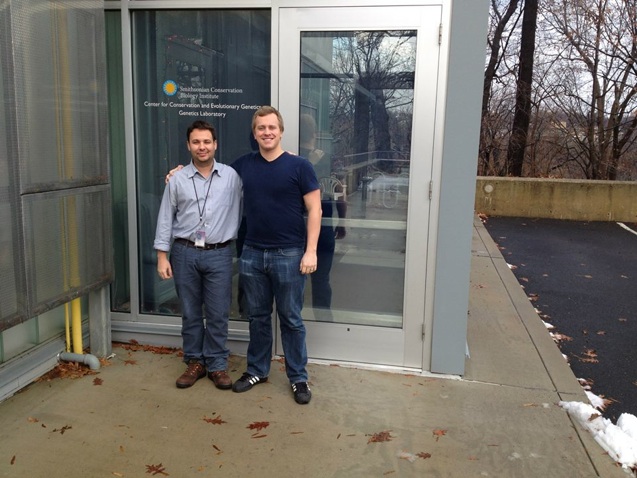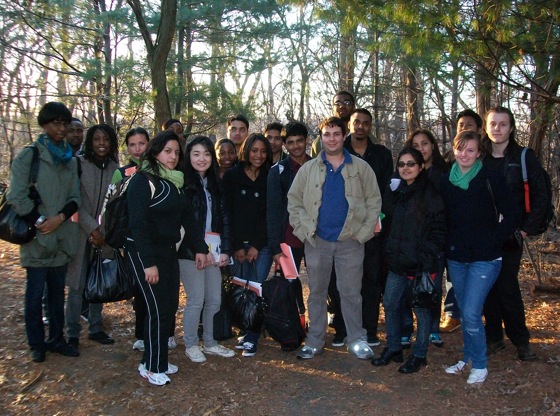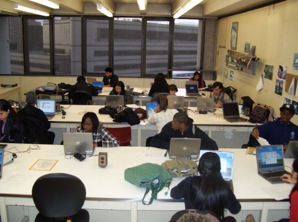Teaching evolutionary biology, systematics, biogeography, and mammalogy to the next generation of scientists is one of my career interests. I have gathered teaching experience in various ways, including mentoring students in a number of research projects, curricula design, teaching several undergraduate university courses, and creating educational materials.
Student mentorships
I have provided mentorship and supervision to students in the City University of New York, the Smithsonian Institution, and the Instituto Venezolano de Investigaciones Científicas.
Mentorship at the Instituto Venezolano de Investigaciones Científicas (IVIC)
Student and date of mentorship and supervision: Marcial Quiroga-Carmona (master student; 2016–in progress)
Thesis title: Biogeografía y conservación de los ratones del género Aepeomys Thomas 1898 (Mammalia, Rodentia, Cricetidae) en los Andes venezolanos
Formal advisors: Dr. Eliécer E. Gutiérrez and Dr. José R. Ferrer-Paris
Institution: Centro de Ecología, IVIC
Program: Master Program in Ecology.
Student and date of mentorship and supervision: Marcial Quiroga-Carmona (master student; 2016–in progress)
Thesis title: Biogeografía y conservación de los ratones del género Aepeomys Thomas 1898 (Mammalia, Rodentia, Cricetidae) en los Andes venezolanos
Formal advisors: Dr. Eliécer E. Gutiérrez and Dr. José R. Ferrer-Paris
Institution: Centro de Ecología, IVIC
Program: Master Program in Ecology.
Mentorship at the Smithsonian Institution
Student and date of mentorship: Marcus Litchfield (undergraduate student at Grant MacEwan University; Winter 2013)
Project title: Molecular techniques for studying the systematics of Americas’ deer
Formal advisors: Dr. Eliécer E. Gutiérrez and Dr. Jesús E. Maldonado
Host institution: Smithsonian’s Center for Conservation and Evolutionary Genetics, National Zoological Park
Internship program: Alberta-Smithsonian Internship Program
Student and date of mentorship: Amy Rutter (undergraduate student at Penn State University; Summer 2013)
Project title: Morphometrics and taxonomy of the Neotropical deer genus Mazama
Formal advisors: Dr. Eliécer E. Gutiérrez and Dr. Kristofer M. Helgen
Host institution: Smithsonian’s National Museum of Natural History
Internship program: Natural History Research Experiences
Student and date of mentorship: Marcus Litchfield (undergraduate student at Grant MacEwan University; Winter 2013)
Project title: Molecular techniques for studying the systematics of Americas’ deer
Formal advisors: Dr. Eliécer E. Gutiérrez and Dr. Jesús E. Maldonado
Host institution: Smithsonian’s Center for Conservation and Evolutionary Genetics, National Zoological Park
Internship program: Alberta-Smithsonian Internship Program
Student and date of mentorship: Amy Rutter (undergraduate student at Penn State University; Summer 2013)
Project title: Morphometrics and taxonomy of the Neotropical deer genus Mazama
Formal advisors: Dr. Eliécer E. Gutiérrez and Dr. Kristofer M. Helgen
Host institution: Smithsonian’s National Museum of Natural History
Internship program: Natural History Research Experiences
Mentorship at the City University of New York
Students and date of mentorships: Sean D. Claxton (2006), Ali Raza (2006–2007), Nadir Rana (2006–2007), Judith Rivas (2009–2010), Jaiho Chang (2009–2010), Robert Boria (2011)
Projects: Undergraduate research , including Honors thesis, Independent study, and various side projects
Formal advisor: Dr. Robert P. Anderson
Host institution: City College of the City University of New York
Courses taught
Courses taught at Universidade de Brasília
Courses taught at City College of New York
Courses taught at Universidad de Los Andes (Venezuela)
Talks given as invited guest in university courses
- Tópicos em Ecologia 323179 [course in the Ph.D. program in Ecology], 30 hours total, Tópicos em Ecologia: Modelagem de Nicho e Filogeografia [Ecological Niche Modeling and Phylogeography], October–November 2016
Courses taught at City College of New York
- Biology 10200, 4-hour laboratory (each of the two sections), Foundations of Biology II (laboratory section), Fall 2011
- Biology 10200, 4-hour laboratory (each of the two sections), Foundations of Biology II (laboratory section), Spring 2011
- Biology 10200, 4-hour laboratory (each of the two sections), Foundations of Biology II (laboratory section), Fall 2010
- Biology 10200, 4-hour laboratory (each of the two sections), Foundations of Biology II (laboratory section), Spring 2010
- Biology 22800, 4-hour laboratory (each of the two sections), Ecology and Evolution (two laboratory sections), Fall 2009
- Biology 22800, 4-hour laboratory, Ecology and Evolution (each of the two sections), Spring 2009
- Biology 22800, 4-hour laboratory, Ecology and Evolution (each of the two sections), Fall 2008
- Biology 22800, 4-hour laboratory, Ecology and Evolution (each of the two sections), Spring 2008
- Biology 22800, 4-hour laboratory, Ecology and Evolution (each of the two sections), Fall 2007
- Biology 22800, 4-hour laboratory, Ecology and Evolution (each of the two sections), Spring 2007
- Biology 10200, 4-hour laboratory, Foundations of Biology II (laboratory section), Fall 2006
- Biology 10200, 4-hour laboratory, Foundations of Biology II (laboratory section), Spring 2006
- Biology 10000, 4-hour laboratory, Strategy of Life (recitation section), Fall 2005
- Biology 10200, 4-hour laboratory, Foundations of Biology II (laboratory section), Fall 2005
Courses taught at Universidad de Los Andes (Venezuela)
- Ecología Animal (laboratory section), semester 1997B
- Ecología Animal (laboratory section), semester 1997A
Talks given as invited guest in university courses
- Biology 22800, Ecology and Evolution. Lecture course. Topic: species richness and diversity, island biogeography, 4 March 2009. City College of New York
- Biology 22800, Ecology and Evolution. Lecture course. Topic: Hardy-Weinberg equilibrium, 9 March 2008. City College of New York
- Biology 22800, Ecology and Evolution. Lecture course. Topic: population growth, 6 February 2008. City College of New York
|
I actively participated in the design of the curriculum of the course Ecology and Evolution at City College, developing and incorporating new topics and exercises for a laboratory manual (see Publications), particularly on modern aspects of ecology and evolution (e.g., the use of species records, climatic data, and Geographic Information Systems to create models of climatic suitability and species’ potential distributions).
The photo at the right show undergraduate students learning how to create models of potential distribution using bioclimatic variables, geographic coordinates of collecting localities of Andean birds and the software DIVA-GIS. This picture was taken at a laboratory session of the course Ecology and Evolution during Fall 2008. |
Copyright © 2015-2017




